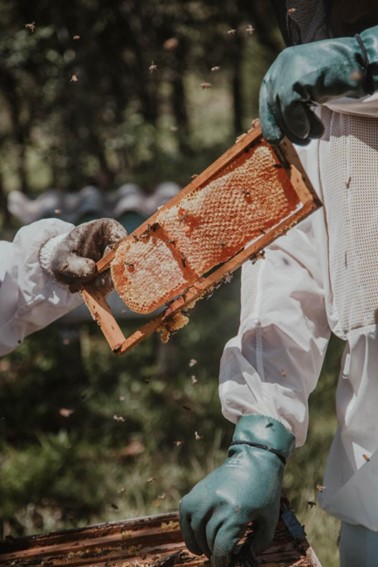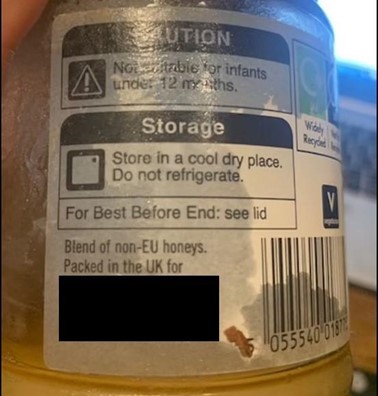Food Fraud in Honey and Maple Syrup

This post is also available in:
This post is also available in:
![]() Español (Spanish)
Español (Spanish) ![]() Français (French)
Français (French) ![]() Deutsch (German)
Deutsch (German) ![]() हिन्दी (Hindi)
हिन्दी (Hindi) ![]() Ελληνικά (Greek)
Ελληνικά (Greek) ![]() Português (Portuguese (Brazil))
Português (Portuguese (Brazil))
Food fraud in honey refers to the intentional adulteration or misrepresentation of honey products in order to deceive consumers or increase profits. There have been several high-profile incidents of honey fraud in recent years.
Despite labelling their food as a pure product, some companies have previously mixed honey or maple syrup with cheaper sweeteners such as corn syrup, rice syrup, sugar beet syrups, or cane sugar. This reduced production costs, but consumers still paid the full price for pure honey or maple syrup, with the extra profit going to the companies. Honey fraud is one of the most widespread food frauds in history. It ranks alongside wine and olive oil as the three most frequently forged and sold products on the planet. “Unfortunately, it is not as bad as the horsemeat scandal. People could just put that meat just below a microscope and go, ‘that’s not beef; that’s horsemeat’. With honey, it’s much much more sophisticated than that. This happens because you’ve got huge factories principally in China, which are making tailor-made syrup designed to mimic honey and to pass the tests”, the London-based honey sommelier Sarah Wyndham-Lewis mentions.
The problem is widespread; in 2013, the US Justice Department charged two major honey importers in ‘Operation Honeygate,’ which became the largest food fraud incident in US history (3). An analysis from the Honey Authenticity Project lab of 13 UK supermarket brands, from 2020-2022, found that none complied with EU labelling standards and couldn’t be called ‘real honey’ (Picture 1), after being subjected to more than 240 tests (4).

Picture 1. Beekeeper producing real honey.
Honey laundering is now so widespread that budget supermarkets in the UK are selling it for 80p – far lower than the cost of production worldwide (about £3.50 per kilo). This consumer deception is not only hurtful in itself but could cause harm to health as evidenced by the National University of Malaysia in 2018, which claims that consumption of adulterated honey increases blood glucose levels, induces obesity, and demonstrates toxicity effects; additionally, its critical finding was that on a 16-week study carried out on rats, 31.25 % of those who were fed with fake honey were dead on week 7 and the rest showed abnormal behaviour like aggressiveness, excessive drinking intake, tachycardia, thinning hair, lethargy, heavy breathing, and increase in body weight, body mass index, fat pads, triglyceride, cholesterol and glucose levels, which indicates that adulterated honey consumption leads to toxicity effects in liver and kidney, obesity and potentially diabetes (5). The easiest way for a consumer to get honey is to look at the label. Sarah advises avoiding anything with the word ‘blend’ on it – as ‘there’s never any reason to blend honey’. Particularly, avoid anything that says ‘blend of non-EU honeys’ as it is an indication that it might be full of sugar syrups (Picture 2). According to some estimates, these Chinese factories are now producing more honey than all the bees on the planet. The honey is then typically sent to factories to be blended with other honey — and possibly other substances as well, such as inexpensive rice syrup. The Chinese authorities are aware of such practices and say they are working hard to detect them. “Honey should be from a single source – and, as such, becomes a perfect picture postcard of that time, that place, and the specific forage that the bees are bringing into the hive. That is its authenticity.” Sarah mentions. Global output has increased by nearly 50% over the last two decades. During the same time period, the number of farmed beehives increased, but by less than 30 per cent to about 90 million, according to the UN’s Food and Agriculture Organization. Beekeepers are concerned that cheap imports will drive them out of business, resulting in fewer bees pollinating crops, wildflowers, and trees, threatening ecological disaster.

Picture 2. An analysis from the Honey Authenticity Project lab of 11 UK supermarket brands found that none complied with EU labelling standards and couldn’t be called ‘real honey’. Anything that says blend should be avoided, especially if it mentions non-EU honeys (3).
So, blending honey from various sources results in a completely anonymized product with no provenance. There is no authenticity, and the blend has been highly processed. As some large supermarkets and honey packers claim, a blended honey cannot be ‘traced back to the hive’. That’s Greenwash”. Sarah believes that instead of banning fake honey, labelling should be changed to make it clear that it is not a natural product. “We shouldn’t be banning cheap commodity ‘honey’ though, because that becomes undemocratic and unhelpful. Instead, we should try to define it more precisely. So, we have a really good model in the maple syrup industry. You have two products right next to each other. One is a cheap version clearly labelled ‘maple flavoured syrup’ and right next to it is certified maple syrup – the real deal – a natural product with provenance that costs three or four times as much. As a consumer, the choice is clear to you, and you can make it according to your purse and preference”, Sarah adds (3).
Further reading
Which Factors Affect Honey Quality
Honey Legislation: Parameters, Criteria & Limits
Honey Types and their Characteristics
References
- https://www.fda.gov/food/compliance-enforcement-food/economically-motivated-adulteration-food-fraud
- Brooks, C. at al. 2021 A review of food fraud and food authenticity across the food supply chain, with an examination of the impact of the COVID-19 pandemic and Brexit on food industry. Food Control, Vol. 130, 108171.
- https://www.dailymail.co.uk/femail/article-10305039/Is-honey-cupboard-FAKE-Expert-reveals-simple-ways-tell.html
- https://www.facebook.com/HoneyAuthenticityNetwork/
- Suhana S. et al, 2018 Adulterated honey consumption can induce obesity, increase blood glucose level and demonstrate toxicity effects. UKM, Sains Malaysiana, 47 (2). pp. 353-365. ISSN 0126-6039








































































